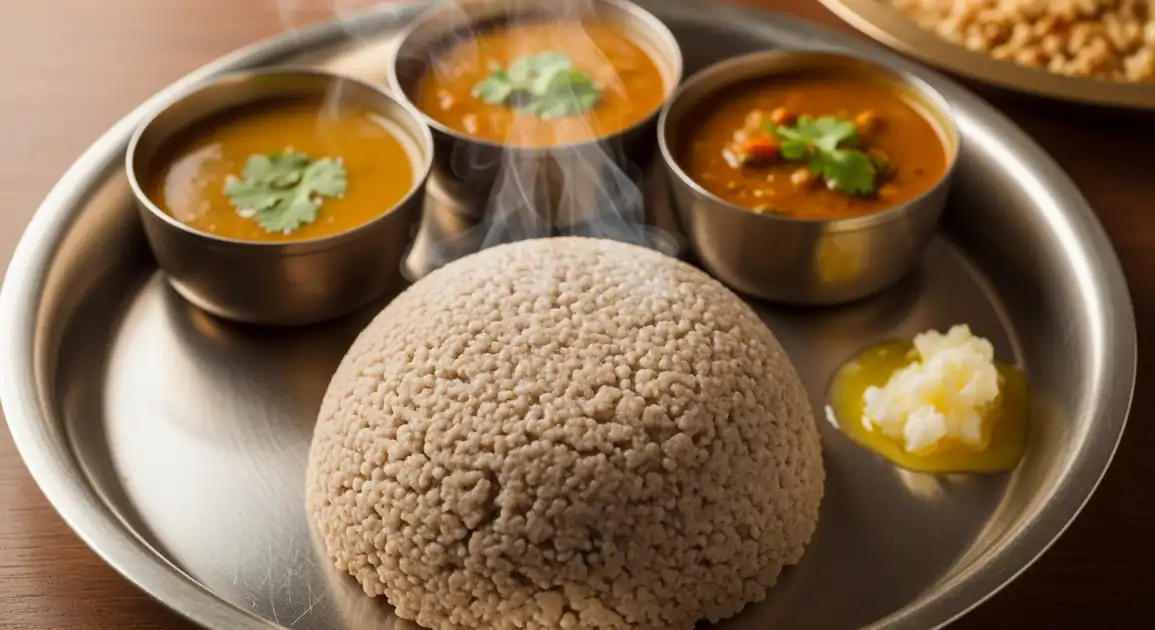Dhindo (Nepali Porridge/Dough)
ढिँडो

Description
Dhindo is a staple food across Nepal, especially beloved in the hilly and mountainous regions where grains like buckwheat and millet thrive. While Dal Bhat (rice set) is more common nationwide, Dhindo holds significant cultural importance and is readily available in restaurants serving authentic Nepali or Thakali cuisine, as well as in rural homes.
Dietary Information
Serving information
Serving style
Served hot as the main component of a Nepali Thali set, replacing rice. Presented as a large mound on a metal plate, surrounded by small bowls containing dal, gundruk soup, tarkari, achar, and often ghee.
Quick facts
Lunch service typically 11:30 AM - 3 PM. Dinner service typically 6 PM - 10 PM.
Safety Tips
What to Look For
-
Served steaming hot
Ensures the Dhindo is freshly cooked and pathogens killed during boiling. Dhindo cools quickly and texture changes.
-
Smooth, homogenous consistency
Well-made Dhindo should be free of lumps ('dalla'). Lumps indicate improper cooking.
-
Fresh-looking and properly stored side dishes
Dal, tarkari, achar should appear fresh. Ensure curries are hot and pickles/salads handled hygienically.
-
Clean restaurant environment
General cleanliness of the eating area and kitchen (if visible) is a good indicator of overall hygiene standards.
-
Made with boiled water
The water used for cooking must be thoroughly boiled to ensure safety, which is inherent in the Dhindo preparation process itself.
What to avoid
-
Lukewarm or cold Dhindo
Unpleasant texture and potential safety risk if left sitting out.
-
Lumpy or watery Dhindo
Indicates poor preparation, although not necessarily unsafe if hot.
-
Side dishes (especially meat/dairy) left at room temperature for long periods
Increases risk of spoilage and foodborne illness.
-
Visibly unclean serving utensils or plates
Potential source of contamination.
Price information
Price range
Budget tips
- Prices are generally affordable, especially in local eateries outside main tourist hubs.
- A full Dhindo set ('Dhindo Thali') provides a complete, filling meal.
- Look for 'Thakali Khana Ghar' (Thakali eating houses) for authentic sets.
Value indicators
- Served steaming hot and freshly made.
- Smooth consistency (not lumpy).
- Generous portions of flavorful side dishes (dal, tarkari, gundruk, achar).
- Option to specify flour type (buckwheat, millet, corn).
Where to Find This Dish
Thakali Restaurants
Specialty restaurants focusing on Thakali cuisine are renowned for excellent Dhindo sets.
Found in major towns and cities nationwide
Lunch, Dinner
Restaurants Serving Nepali Cuisine
Most restaurants offering general Nepali set meals will have Dhindo as an option.
Tourist areas (Thamel, Lakeside) and local neighborhoods
Lunch, Dinner
Rural Teahouses/Lodges
Commonly served along trekking routes and in villages.
Trekking trails, Rural settlements
Lunch, Dinner
Vendor Tips
- Ask for the type of flour used ('Kun pitho ko?') if you have a preference or dietary need (e.g., gluten-free).
- Refills ('thap') of side dishes (dal, tarkari) are often offered for free with set meals.
- Don't hesitate to ask for ghee if it's not automatically served.
How to Order
Regional Variations
-
Buckwheat Dhindo
(फापर को ढिँडो (Fapar ko Dhindo))
Made from buckwheat flour. Common in higher altitudes. Greyish-brown color, slightly nutty, earthy flavor. Gluten-free.
-
Millet Dhindo
(कोदो को ढिँडो (Kodo ko Dhindo))
Made from finger millet flour. Dark brown color, distinct robust flavor. Popular among Gurung and Rai communities. Gluten-free.
-
Cornmeal Dhindo
(मकै को ढिँडो (Makai ko Dhindo))
Made from cornmeal (maize flour). Yellowish color, slightly gritty texture, mildly sweet taste. Gluten-free.
-
Wheat Dhindo
(गहुँ को ढिँडो (Gahun ko Dhindo))
Made from whole wheat flour. Less traditional than other types but sometimes found. Lighter color. Contains gluten.
Cultural context
History
Dhindo has been a cornerstone of Nepali cuisine for centuries, especially among ethnic groups like the Gurung, Magar, Rai, Limbu, and Tamang inhabiting the hills and mountains where rice cultivation was difficult or insufficient. Its ingredients – hardy grains like buckwheat and millet – grow well at higher altitudes. Dhindo provided essential energy and sustenance for agrarian communities involved in strenuous physical labor. It represents resilience, simplicity, and connection to the land.
Local significance
A symbol of Nepali identity, resilience, and connection to the land. Considered highly nutritious and energy-giving, suitable for hard work.
Eating customs
- The traditional method of eating with the right hand, rolling into balls, dipping, and swallowing.
- Considered impolite by some elders to chew Dhindo extensively.
- Enjoying the interplay of Dhindo's neutral base with the strong flavors of the accompaniments.